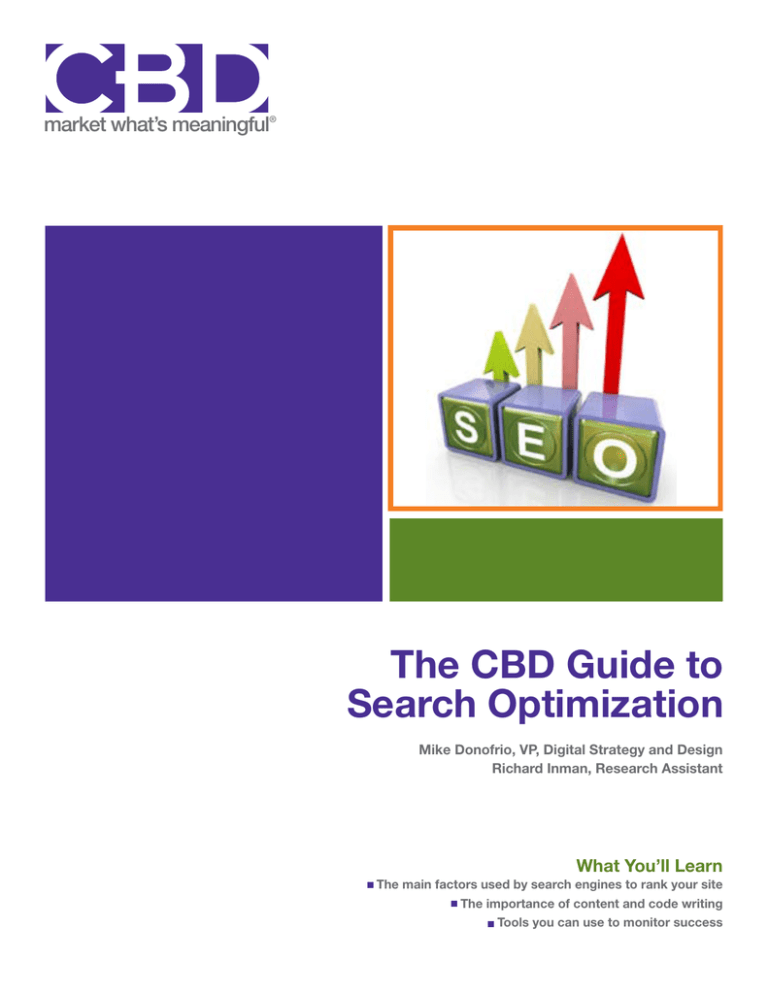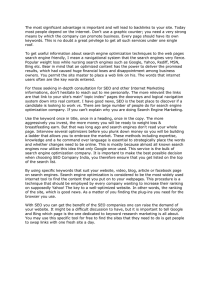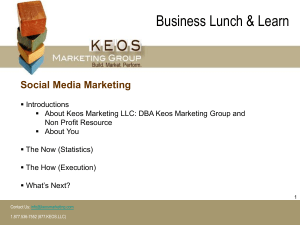The CBD Guide to Search Optimization
advertisement

market what’s meaningful® The CBD Guide to Search Optimization Mike Donofrio, VP, Digital Strategy and Design Richard Inman, Research Assistant What You’ll Learn The main factors used by search engines to rank your site The importance of content and code writing Tools you can use to monitor success Introduction to SEO Search engine optimization (SEO) is a tool of Search Engine Marketing (SEM) used to increase visibility of your website on sites like Google, Bing or Yahoo. There are two methods of appearing on these search engines: appearing as paid links, or showing up as an organic result on the main section of the Search Engine Results Page (SERP). While SEM refers to the topic of being seen on these search engines as a whole (often paid), SEO is the practice of being visible on organic searches. SEO is a powerful strategy to boost your website’s ability to reach potential customers. The dynamic of online marketing is quickly changing from outbound to inbound, pushing aside the former commonplace media like yellow pages, radio and newspaper advertisements. With around 700,000 searches-per-second on Google (according to 2011 data compiled by Go-Globe), a website that hesitates for just one second could lose hundreds or even thousands of interactions from the information-hungry or buyer-ready. Paid searches appear to be an enticing alternative to ensure that your website reaches the first results page. However, a study by quora.com found that 88% of search engine users never click on paid search ads. How do search engines like Google, Bing and Yahoo prioritize where a certain website will be placed on the SERP when a related keyword is searched for? The two main factors that comprise an algorithm for the SERP are in the hands of the website builder. They are: Linking to your website Search engines rank a website on their SERP partially by the number of inbound links going to that individual page. The links are weighed by the credibility and popularity of the website that’s linking to them (e.g. an inbound link from The Wall Street Journal site would be worth more than a link from a small blog). Content To determine what content is prudent to the search, the search engines attempt to index each and every website in the Internet universe to display the most relevant content when a user inserts a query. Programs designed by these search engines then scan through sites to gather information on the unique topics, tags and descriptions. These will be addressed in detail in the “Your Site” and “Content” sections respectively. CBD market what’s meaningful® The CBD Guide to Search Optimization 2 Your Site Relevance Targeted search engine inquiries are crucial for obtaining a high rank on the SERP. Search engines look for more than just keywords on your website; they scan through your site’s structure, the keywords in the page headings, and page formatting. As there are no tools to quantify relevance of a website, remember it is always a priority to provide relevant and articulate content for your audience to digest. A high rank on the SERP should be the ultimate goal of any website. It reflects the site’s relevance in the subject, credibility and online marketing efforts. The site should be using key terms, unique pages and blogs to drive itself further up the SERP. Search engines determine what your rank on their SERP will be for related keywords by authority and relevance. The bad news is there are countless factors that are beyond your control when a search engine is ranking. The good news? There are many aspects within your control. Let’s review them. Google’s SEO Guide presents many ideas to facilitate visibility for search engines and usability for visitors. Specific examples will be covered in the “Code” section of this manual, as the tips are mostly for the back-end code of website development. However, it is important to understand that navigation, usability and presentation of information in a concise and easy-to-read manner are also taken into consideration for search engine ranking. Authority The value of your site’s authority is derived from the number of websites externally linking to you. Search engines use these inbound links to determine how authoritative and credible your website’s content is. As mentioned in the previous section, a website with inbound links from more credible websites will be weighted heavier on search engine results than a page with only links from blogs or low-traffic sites (such as directories). You can monitor the authority of your website through several online tools such as alexa.com, HubSpot’s Marketing and Google’s PageRank. Search engines are designed to “think” like humans when indexing the millions of Internet web pages to return the results most relevant to the user. When creating and formatting content for SEO, it is imperative to facilitate the search engine’s job in order to get you that higher rank. Best practices for achieving this come from staying relevant and authoritative to the indices through the content and code of the website. Using links from your own social media, RSS feeds and blogs can offer a simple method of gaining authority on SERPs. The amount of social activity connected to a web page (likes, shares, links, +1’s, etc.) factors into the indexing algorithm. Search engines have determined that content from social networks is highly influential and is therefore authoritative to the mind of the index. To guarantee that you’re getting the most from your social media outlets, be diligent in making your content as easy as possible to share. Finally, adding buttons to connect with your various social media pages facilitates communication with your audience, so make sure they appear on each page. CBD market what’s meaningful® The CBD Guide to Search Optimization 3 Content Keeping the site user-friendly and easy to navigate A site with easy-to-read text and accessibility will increase repeat traffic and improve the authority of your site. Headings, smaller paragraphs, pictures and videos will help readers access the information they are searching for without having to scroll through blocks and blocks of text. Search engine algorithms consider many traits when ranking websites on the SERP, but for achieving organic (word-of-mouth) credibility, quality content is ultimately the deciding factor. Describing what you offer—with precision—should be your ultimate goal. Google’s SEO Guide breaks down the essentials of content management: 1. Maintaining topicality with fresh content 2. K eeping the site user-friendly and easy to navigate 3. Accurately describing the page’s content Accurately describing the page’s content Google insists that the description portion of the site code should be used to inform what could be useful in a search inquiry. They recommend avoiding the common mistake of using vague or default titles for each web page by letting it be described as “Untitled” or “New Page.” Such description should be used wisely, because this could determine whether interior pages other than your default make it onto the SERP. Maintaining topicality with fresh content Organizing your content to match the interests of your desired audience is a no-brainer in content development; however, staying on topic holistically for your website is a universal concern. The content creator should break up the text into logical chunks to help users find the information they need easily and quickly. Regularly updating the site with new topical content will keep your visitor base coming back, and also bring in new visitors. Duplicate content and unwarranted beefing up of keyword usage should be avoided. CBD market what’s meaningful® The CBD Guide to Search Optimization 4 Code Every web page connected to your website has its own individual title tag, which is separate from the text headline of the page. This is the tag that appears as the blue link when search engines list your webpage on their SERP. Below this title tag and the website URL on the SERP is the meta tag you can include with the head of your site HTML. There are two parts of the meta tag – the meta description and meta keyword. The search engine derives its original rank for your website from the URL for each specific page. The URL is meant to help the search engine understand the content of the page and index it as such. Website design software will insert meaningless numbers and letters in the URL as a default, but this should be changed to give a pertinent title to the webpage. Internal Linking can help out search engines by emphasizing important parts of your content. It is the practice of referencing other pages of your website in your text through links. Pictures on your site are also very valuable, not only to break up large chunks of text, but to improve the index’s accuracy of your website content as well. When adding images to your web pages, be sure to title them with relevant names (instead of default names like “photo123.jpeg”), because search engine indices cannot determine an image’s content simply from scanning it. Another way you can use pictures to aid these indices is by adding “alt tags,” or little bits of code that allow you to tag photos with a short text blurb. Image courtesy of ogosense.com Meta Descriptions are 150-character-limit bits of text that describe what your webpage is about. You have the option of adding this to your HTML code, or search engines will take text from your website to use as the meta text. Meta Keywords are an additional part of the HTML code that allows you to add keywords that relate to your web page. While most search engines do not view meta keywords when indexing, some smaller search engines might, so it is valuable to include around 5—7 keywords in this section of the code, just in case. It’s a best practice to keep these words to a minimum. Image courtesy of ogosense.com CBD market what’s meaningful® The CBD Guide to Search Optimization 5 Monitoring Success After implementing your SEO plan, measuring traffic increases to your website is the key gauge for determining success, but there are many other ways of monitoring improvement on the SERP. Tools like Google Analytics can give you a detailed picture of what the average visitor experiences on your website. As simple as determining how many people are reaching your site from organic searches to narrowing down the customer conversions and plotting the path they took to find you, these sites can be crucial in the long term for assessing a return on investment and adapting your SEO plan. SERP. Use this information to create content and reach new audiences. Inbound Links Many online applications can also show you the number of webpages you’ve created that are linked by other sites. This number should always be increasing in every monthly indexing check. If not, reviewing the best practices from the “Content” and “Code” sections of this manual should be first and foremost in your SEO efforts. Using sites mentioned in the “Your Site” section to check your inbound link count should also be used to track the external popularity of the website. Image courtesy of HubSpot.com Keyword Audit Continue to improve your rank on the SERP by following up with keyword research. Making a list of keywords, as extensive as possible, would be incredibly beneficial for monitoring how successful you’ve been on the SERP. Make sure to rank them in order of relevance to your business to prioritize your SEO efforts and track your progress. However, do not assume that this is the complete list of keywords linking to your website. The HubSpot tool, Keyword Grader, lists the keywords your site ranks for on the Keep pages relevant and fresh Content is king. Adding extra pages of content based upon your keyword research is advantageous. Keyword research should reflect which inquiries lead to your site, giving you a good idea of what topics you should cover and highlight on these new webpages. Blogging about these topics creates even more reason for searchers to visit you, where they can add comments and link to your site—continuing to enhance search. Every blog post is a new web page to be discovered by the search engines, stacking the odds in your favor. CBD market what’s meaningful® The CBD Guide to Search Optimization 6 Acknowledgements Information from the following have been used in The CBD Guide to Search Engine Optimization: CBD market what’s meaningful® The CBD Guide to Search Optimization 7 market what’s meaningful® About CBD Marketing CBD is a B2C and B2B marketing services agency that clarifies and articulates what’s most meaningful about your brand, product or service and helps you build more intimate and profitable relationships with your customers. At the heart of everything we do is a deep understanding of the rational and emotional drivers that inspire your customers’ choices. At CBD, “market what’s meaningful” is our mission, guiding all disciplines from brand development to media strategy, from public relations to creative. In the realm of digital communications the power of interactivity is harnessed to create meaningful experiences that evoke emotion, foster brand engagement and create customer loyalty. The ultimate goal is to provide customers with irresistible reasons to take action by utiliziing the unique properties of the interactive mediums — from websites and banner ads to mobile apps and interactive sales tools — that comprise the constantly evolving digital environment. Let’s Talk! To talk about how CBD can help you create moments that matter to your audience and better connect them to your brand, product or service, please contact Doug Davila, Director of Business Development at 312.661.1050 or ddavila@cbdmarketing.com. © 2012 Colman, Brohan & Davis, Inc. 54 W. Hubbard St. Concourse Level East Chicago, IL 60654 8





